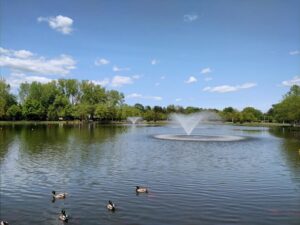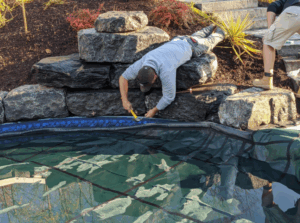If you want to install a fountain in your garden or pond, there are a few things to keep in mind. Many fountains range from simple to elaborate, including aerating and floating models. The key is to choose the right model for your needs and budget.
Floating Pond Fountains
Floating pond fountains are a great way to keep a pond looking beautiful and clean. They can also provide much-needed aeration. Adding oxygen to the water can reduce excess nutrients and decompose more quickly. Aeration can also help combat foul odors.
A floating pond fountain can be a great addition to any pond. Depending on the model, you can have a variety of different features. For example, some fountains have lights. These can be powered by a photocell or by a control panel.
Most pond fountains will also have several spray patterns. You can choose from basic spraying trumpets to complex patterns with multiple streams of water. Some fountains are equipped with hand tools that allow you to change the spray pattern.
When purchasing a pond fountain, consider the pond fountains price and the warranty. The price of a fountain will be higher if it comes with a 5-year or more manufacturer’s warranty. However, there are many loopholes in most warranties.
One important thing to keep in mind when choosing a fountain is the power cord length. Ideally, the cord should be long enough to reach where you want the fountain installed. Avoid burying the cord in the sand. This can lead to a damaged cord.
Another item to look for is the pump. The pump is the most expensive part of the fountain. It can be either bolted to the float or mounted horizontally.
Flow rates are another important aspect of a fountain. High-powered pond fountains can flow 90,000 liters per hour. Higher flow rates mean a more aesthetically pleasing display.
The water is often pumped up through a nozzle mounted on a plastic float. A float can be tethered to the shoreline or anchored to the bottom of the pond.
Several companies offer unique lighting options. LED lights are available in several colors, including white and multicolor versions. Light sensors are also available to shut off the light at dawn and dusk.
The AquaMaster brand is known for its high-quality, corrosion-resistant components. Their fountains come with the longest warranty in the industry.
Aerating Fountains: Beauty, Clarity, and Health for Your Pond

Aerating fountains are not only visually stunning—they’re a smart investment in the health and clarity of your pond. By circulating water and increasing oxygen levels, these fountains help prevent algae buildup, reduce foul odors caused by hydrogen sulfide, and protect aquatic life by minimizing the risk of fish die-offs.
Choosing the Right Fountain for Your Pond
The ideal aerating fountain depends on the shape, size, and depth of your pond. For shallow ponds, floating fountains are a popular option. These systems sit on the surface and use a disk or similar structure to spray water upward, creating a decorative display. For deeper ponds, sub-surface aerators may be more effective in circulating water from below.
To add even more drama and elegance, consider integrating LED light kits that can transform your pond into a glowing nighttime centerpiece.
Performance Matters
When selecting an aerating fountain, it’s important to choose one with sufficient horsepower to handle your pond’s size. Undersized or poorly made units can do more harm than good—potentially stressing fish or damaging your pond’s ecosystem. Investing in a reliable, high-quality model is key.
Most residential models run on 115 volts, making them budget-friendly and easy to install. Larger or commercial-grade systems may require 230 volts, offering more power but at a higher cost.
Kasco: A Trusted Name in Water Quality
For over 50 years, Kasco has been a leader in the aerating fountain industry. Renowned for durability, efficiency, and design innovation, Kasco has set the standard in water management systems. Their VFX line offers versatile options tailored for a wide range of pond sizes and applications, all designed with easy operation and maximum aeration in mind.
Need help visualizing your fountain before purchasing? Kasco’s virtual fountain viewer lets you preview various models in a simulated pond setting, helping you select the perfect style. Once you’ve chosen your fountain, don’t forget to determine the proper horsepower and power cord length to match your setup.
Whether you’re enhancing a backyard pond or maintaining a larger water feature, an aerating fountain can make all the difference in water quality—and style.
Sub-Surface Air Diffusers: Boosting Pond Health from the Bottom Up
Sub-surface air diffusers are a powerful way to enhance water quality in your pond by delivering oxygen where it’s needed most—at the bottom. These systems release streams of bubbles that rise through the water, promoting oxygen transfer from the lower depths to the surface. This circulation helps prevent algae blooms, supports aquatic life, and improves overall clarity.
How They Work
These systems operate with a land-based compressor that pushes air through tubing to one or more diffusers placed on the pond floor. The diffuser often a membrane-style disc or tube releases air in a steady stream of bubbles, creating a gentle, vortex-like motion that mixes the water column and breaks surface tension.
Shallow Ponds See the Biggest Benefit
Sub-surface diffusers work best in ponds shallower than eight feet. In deeper ponds, the effectiveness of oxygen transfer decreases. However, they still offer excellent water circulation, which is essential for reducing stagnation and preventing sediment buildup.
Types of Diffusers: Coarse vs. Fine Bubbles
There are two main types of diffuser systems:
-
Coarse bubble diffusers: Ideal for general water mixing, these are durable and low-maintenance but don’t transfer oxygen as efficiently.
-
Fine bubble diffusers: These are better at oxygen transfer due to their smaller bubbles, which have more surface area—but they require more frequent maintenance.
Installation Tips and System Designx
To ensure even aeration across your pond, multiple diffusers may be required, especially in larger or irregularly shaped water features. Strategic placement is key spacing them evenly and ensuring they’re protected from weather and debris will prolong their life and boost performance.
As an example, a diffuser placed at a depth of one foot can aerate roughly a two-foot diameter around it. Shallow ponds often need more units to ensure full coverage.
Why Choose a Sub-Surface System?
Unlike decorative fountains, sub-surface aerators are low-profile and focus entirely on improving water health. Of course, if you want both beauty and function, they can be used alongside a floating fountain for visual appeal and added surface aeration.
And yes—there’s something surprisingly soothing about the gentle bubbling sounds these systems produce.
Once you’ve chosen a sub-surface aerator, be sure to install it on a stable, elevated base rather than directly on the pond floor. This helps avoid sediment intake and premature wear. A proper setup will ensure your pond remains clean, clear, and thriving all year long.
Choosing the Right Fountain Pump

When it comes to selecting a fountain pump for your pond, one of the most important factors to consider is lift—the vertical distance from the surface of the water to the highest point of the fountain spray. A pump that’s too weak will result in a disappointing trickle rather than a showstopping display. To avoid this, opt for a pump that has a lift capacity at least 1.5 times the desired fountain height.
Pond Size Matters
The size of your pond plays a major role in choosing the appropriate pump. Whether your pond is just over a quarter-acre or stretches up to two acres, you’ll need a pump that can handle the job. For smaller ponds—especially those under a quarter-acre—look for a pump with enough power to lift water at least 1.5 times the pond’s depth. A good rule of thumb for flow rate is to select a pump that delivers at least 200 gallons per hour per inch of fountain height.
Tubing Length and Diameter
Tubing is another crucial component that’s often overlooked. It typically ranges from 1 to 10 feet in length, and its diameter should match the pump’s discharge size to ensure optimal water flow. Also, measure the exact distance from the pump to the fountain outlet to determine the correct tubing length. Longer or narrower tubing can reduce water pressure, so choose wisely.
Fish Load and Water Circulation
If your pond is densely stocked with fish, you’ll need a more powerful pump that can circulate the pond’s full volume at least twice per hour. On the other hand, lightly stocked or ornamental ponds may only require circulation of a few hundred gallons per hour. The more aquatic life you have, the more oxygen and circulation your pond needs.
Controlling Flow for the Perfect Display
Using a high-lift pump not only helps your water reach greater heights—it also allows for better control over flow. Adding a ball valve or a PVC flow control system enables you to fine-tune the water pressure to achieve your desired spray height and fountain style.
Waterfall Considerations
If your pond includes a waterfall, don’t forget to factor in its height and width. For example, a 12-inch-wide spillway will typically require between 1,200 and 1,800 gallons per hour for a strong, elegant cascade.






